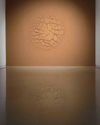
The 5000 sq. ft. pavilion at the Kochi-Muziris Biennale (2022-23), designed and built by Samira Rathod Design Atelier (SRDA), is a large enclosure built entirely out of construction debris.
Event pavilions, almost as a rule, have to address questions of impermanence – materials like bamboo and light steel can and are often repurposed. What is special about Rathod’s pavilion is that it is made of matter that has been discarded as useless – chipped tiles, broken walls, brick pieces, junked granite, among other things.
With a large sloped roof, the building is suffused by a different and deflected sense of time and memory. The walls and the roof allow the light to enter through the crevices of its shattered material. This porosity makes for a fragmented, airy space, with skylights offering patches of brightness over a cement floor run through with waste pieces of quarried granite. The large windows at the top swing open with the turning of a handle at the bottom, a small gesture that translates into a big move. This ‘architecture of salvage’ serves not just functionality but also poetry that is corporeal and spatial. The project reprises the ideas of Project Boject, a research initiative that the firm undertook in 2013 in Khetwadi, Mumbai, looking at the possibilities of reassembling detritus to make new buildings. Memories of buildings persist in the reused material; waste is reemployed; and every material and structural aspect of architecture is mobilised to generate a greater delight in the act of inhabiting a space.
هذه القصة مأخوذة من طبعة April 2023 من Art India.
ابدأ النسخة التجريبية المجانية من Magzter GOLD لمدة 7 أيام للوصول إلى آلاف القصص المتميزة المنسقة وأكثر من 9,000 مجلة وصحيفة.
بالفعل مشترك ? تسجيل الدخول
هذه القصة مأخوذة من طبعة April 2023 من Art India.
ابدأ النسخة التجريبية المجانية من Magzter GOLD لمدة 7 أيام للوصول إلى آلاف القصص المتميزة المنسقة وأكثر من 9,000 مجلة وصحيفة.
بالفعل مشترك? تسجيل الدخول

Parts, Wholes And The Spaces In Between
Sonal Sundararajan introduces Samira Rathod's free-spirited and rebellious explorations in the world of architecture, furniture and design.

"The Fine Art of Going to the Pictures."
Dr. Banerjee in Dr. Kulkarni's Nursing Home at Chemould Prescott Road brings together 26 paintings featuring a series of dramatic scenes from Hindi and Bengali films. In conversation with Abhay Sardesai, artist Atul Dodiya talks about childhood trips to movie halls, painted figures gripped by tension, and the closeness and remoteness of cinematic images.

"To Finally Have Something of Your Own to Mine."
Dayanita Singh is the recipient of the coveted 2022 Hasselblad Award. Keeping the photograph at the centre, she speaks to Shreevatsa Nevatia about books, book objects, photo novels, exhibitions and museums.

OF DIVINE LOSS
Shaurya Kumar explores the relationship between the subject and object of devotion, finds Aranya.

THE PAST AND ITS SHADOWS
Neha Mitra visits two shows and three artists in Mumbai.

FORCE OF NATURE
Alwar Balasubramaniam dwells on absences and ephemeralities in his new work, states Meera Menezes.

SHAPES OF WATER
Devika Sundar's works delineate the murky, malleable boundaries between the human body and the organic world, says Joshua Muyiwa.

INTIMATIONS OF INTIMACY
Sunil Gupta shares his journey with Gautami Reddy.

THE FRACTURED PROSPECT
Nocturnal landscapes as ruins in the making? Adwait Singh looks at Biraaj Dodiya's scenes of loss.

TEETERING BEYOND OUR GRASP
Meera Menezes traces Mahesh Baliga's journey from Moodabidri to London.